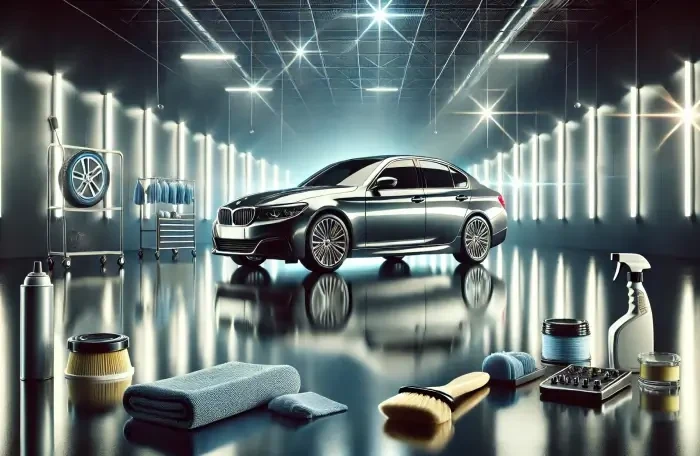Car Detailing Made Easy: 7 Easy To Follow Steps

Lila Claybourne
Sep 20, 2024

Summary
In this detailed guide, you’ll learn how to detail your car like a pro in 7 simple steps, helping you save money while keeping your car in showroom condition. You’ll discover:
What is Car Detailing?
A Step-by-Step Guide to Detailing
Common Detailing Mistakes to Avoid
Essential Products and Tools
Paint Protection Techniques (Wax vs. Sealant vs. Ceramic)
Professional vs. DIY Detailing
Frequently Asked Questions
Car Detailing Like a Pro: The 7 Easy Steps
If you’re tired of paying high prices for professional car detailing, learning how to do it yourself can save you hundreds of dollars while keeping your car looking brand new. This easy-to-follow guide will walk you through each step of the detailing process, from washing and waxing to interior cleaning, so you can achieve professional results at home without the hefty price tag.
7 Steps to Detail Your Car Like a Pro
Wash Your Car with the Two-Bucket Method
Clean Wheels and Tires
Clay Bar Treatment
Polish the Paint
Apply Wax or Paint Protection
Clean and Condition the Interior
Clean the Windows and Apply Final Touches
Follow these steps to give your car a professional-grade detail, whether you’re preparing for resale or just want to keep your car looking its best.
1. What is Car Detailing?
Car detailing goes far beyond a typical car wash. It involves an in-depth cleaning, restoration, and finishing of your vehicle—inside and out. Detailing aims to restore your car to its original condition, or better, by addressing every aspect of its maintenance, from the paint to the interior. This includes removing surface contaminants, polishing the paint, waxing for protection, and thoroughly cleaning the interior.
Why Should You Detail Your Car?
Protect Paint and Interior Surfaces: Detailing prevents fading, cracking, and other damage by removing contaminants and applying protective layers.
Maintain Value: Regular detailing can boost resale value by ensuring your car stays in pristine condition.
Improve Air Quality: Removing dust, allergens, and grime from the interior promotes a healthier driving environment.
2. Step-by-Step Guide to Detailing Your Car
Step 1: Wash Your Car with the Two-Bucket Method
The foundation of detailing starts with a proper wash to remove dirt and grime without damaging your car's paint. Use the two-bucket method: one bucket for soapy water and the other for rinsing your mitt. This reduces the chance of transferring dirt back onto your car.
Tip: Use a microfiber wash mitt to avoid scratches.
Pro Tip: Wash your car in the shade or early morning to avoid water spots caused by sun drying.
Step 2: Clean Wheels and Tires
Wheels and tires are magnets for road grime and brake dust. Use a dedicated wheel cleaner and brush to get into the nooks and crannies. Be sure to rinse thoroughly.
Tip: Use a separate cloth or brush for wheels to prevent cross-contamination with paint.
Pro Tip: For a high-gloss tire finish, use a water-based tire dressing. Avoid silicone-based products, which can attract dirt.
Step 3: Clay Bar Treatment
A clay bar removes embedded contaminants from the paint that washing alone can’t. After lubricating the surface with a detailing spray, glide the clay bar across the paint to lift stubborn particles.
Tip: If you feel resistance, reapply lubricant to avoid scratching.
Pro Tip: Claying is crucial before waxing. It ensures the wax bonds properly and lasts longer.
Step 4: Polish the Paint
Polishing corrects imperfections like minor scratches and swirl marks, restoring the car’s glossy finish. Use a dual-action polisher and work in small sections to avoid overheating the paint.
Tip: Apply polish with a soft pad and remove with a microfiber towel.
Pro Tip: For a flawless finish, use light pressure and follow with a finishing polish for maximum shine.
Step 5: Apply Wax or Paint Protection
Wax or paint sealants add a protective layer to your car’s paint, shielding it from the elements. You can also consider ceramic coatings for more durable, long-lasting protection.
Tip: Apply wax in small, circular motions and buff it out with a clean towel.
Pro Tip: For those seeking longer-lasting protection, ceramic coatings offer superior durability (up to 2 years) and shine compared to wax.
Step 6: Clean and Condition the Interior
Start by vacuuming seats, carpets, and mats. Use interior cleaners and brushes for dash and panels. For leather seats, apply a leather conditioner to prevent cracking.
Tip: Clean air vents with a detailing brush to remove trapped dust.
Pro Tip: To keep your car smelling fresh, use fabric cleaner or baking soda on carpets and seats to remove deep odors.
Step 7: Clean the Windows and Apply Final Touches
Use an ammonia-free glass cleaner to avoid damage to tinted windows. Clean the inside and outside of all windows, wiping in circular motions for a streak-free finish.
Tip: Clean windows last to prevent streaks from other cleaning tasks.
Pro Tip: Always use a separate microfiber cloth for windows to avoid transferring wax or polish residue.
3. Common Detailing Mistakes to Avoid
Detailing your car can be incredibly rewarding, but many first-time DIY detailers make mistakes that can cost them time, money, or even cause damage. Here's how to avoid the most common errors:
Using Household Cleaners: Household cleaners like dish soap can strip the protective wax and damage the car's paint. Always use car-specific soaps and cleaners.
Skipping the Clay Bar: Skipping the clay bar step can trap contaminants under your wax, leading to swirl marks and uneven shine.
Air Drying the Car: Allowing the car to air dry after washing leads to water spots, which can be difficult to remove. Use a microfiber drying towel instead.
Detailing in Direct Sunlight: Detailing in direct sunlight can cause soap and wax to dry too quickly, leaving streaks and making it harder to buff the paint.
4. Essential Products and Tools
To detail your car like a professional, you’ll need some basic tools and supplies. Investing in quality products will give you better results and protect your car's surfaces. Here’s a checklist of the essentials:
Microfiber Wash Mitts and Towels: Soft and absorbent, these are perfect for washing, drying, and buffing without scratching.
Car Wash Soap: Designed to clean without stripping protective layers.
Clay Bar Kit: Removes embedded contaminants from paint.
Dual-Action Polisher: For polishing and removing paint imperfections.
Carnauba Wax, Paint Sealant, or Ceramic Coating: Provides paint protection.
Wheel Cleaner and Brushes: Specialized tools for cleaning wheels and tires.
Interior Cleaner and Brushes: For cleaning dashboards, vents, and upholstery.
Many of these items can be found at Amazon or local automotive stores for a reasonable price.
5. Paint Protection Techniques
Different levels of paint protection can help your car maintain its shine and stay protected from the elements. Here’s a quick comparison of popular options:
Wax: Great for a deep, natural shine but requires frequent reapplication.
Sealant: Offers longer protection and a synthetic finish.
Ceramic Coating: Provides the most durable protection, lasting up to two years with minimal maintenance.
For car owners who want maximum protection with minimal effort, ceramic coatings are ideal.
6. Professional vs. DIY Detailing
Deciding between DIY and professional detailing depends on your budget, time, and expectations:
DIY Detailing: Costs less and gives you control over the process. With the right tools, you can achieve impressive results.
Professional Detailing: Offers expert-level results with less effort on your part, but at a higher price (ranging from $150 to $500 per session).
For those with time and enthusiasm, DIY detailing is a rewarding hobby that can save money. However, for the perfect finish, or if you’re short on time, professional detailing may be worth the investment.
7. Frequently Asked Questions
How often should I detail my car?
For the average car, detailing every 4-6 months is recommended, depending on usage and environmental conditions.
Can I use household cleaners on my car?
No. Household cleaners can damage your car's paint and interior. Always use products specifically designed for cars.
What’s the difference between wax and ceramic coating?
Wax offers short-term protection with a natural shine, while ceramic coatings provide long-term protection and superior durability.
Do I need to clay bar my car every time I detail it?
No. Clay bar treatments are typically done every 6 months or when you feel roughness on the paint.
Conclusion
By following these easy detailing steps, you can ensure your car stays in pristine condition year-round. Whether you’re preparing for resale or simply want your ride to shine, regular detailing goes a long way. Plus, if you ever need to transport your vehicle across the country, you can trust AmeriFreight for professional auto shipping services that keep your car safe and secure.
Related Posts
















